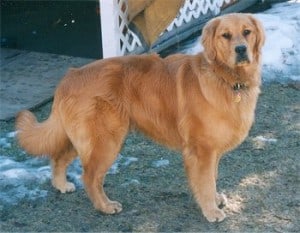Training your Golden Retriever does not have to be a difficult time in your life, or in the life of your dog.
By following a few simple tips and strategies, the process can be pleasant and rewarding for all involved.
The major issue in training a dog is to make sure that your puppy is at the correct stage of its life to be able to understand and internalize the training.
Make training fun
Make sure that you are in a positive and enthusiastic mood when you begin training sessions.
If you are tired, stressed or unhappy this will be communicated to the dog, and it will make the session less pleasant and more difficult.
Take time to praise the puppy when something is done correctly.
Small healthy treats and lots of verbal praise, pets and hugs make the dog feel positive about training sessions. Try to have a play session at the end of each training session when the session has gone well – this will help the puppy focus on the training.
In addition, always exercise your puppy before the training session starts. This allows their excess energy to be burned off and gives the puppy the opportunity to focus.
If a puppy is not exercised before training, it may be focused on running around and having fun rather than on the business of learning.
Most puppies enjoy learning, being praised, and spending time with their owners. They will look forward to these training times if they are done in a positive atmosphere where the puppy feels successful.
Make training natural
Remember that Golden Retriever puppies are not full grown, nor do they have complete control of their body functions.
Take the puppy outside multiple times per day, and positively reward the puppy when it urinates or defecates outside. This process can also work when the puppy sits on its own or comes to you.
Catch them being good and reward swiftly.
Keep training consistent
This is one of the most critical tips for puppies. It is very hard for the puppy to understand expectations if they change from day to day or between people in the house.
Make sure that everyone is using the same commands with the puppy. For example if one person is using “sit” and another is using “down” to get the puppy to sit on its bottom, the puppy will be confused. This gets even more confusing if, when the puppy jumps up, he is told to “get down”.
Keep commands simple and consistent.
In addition to the command language, it is also important to keep the expectations the same between people in the home.
If, for example, the children let the puppy sleep on the bed but the adults insist the puppy stays off the furniture, it will take much longer to teach the puppy.
Talk to other family members about the commands and expectations for the puppy. If you are attending a puppy training class, invite all the family to attend so they can see how the trainer is indicating the commands should be used.

